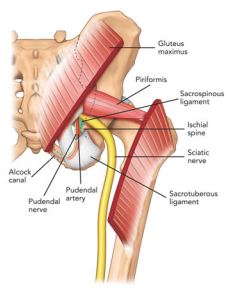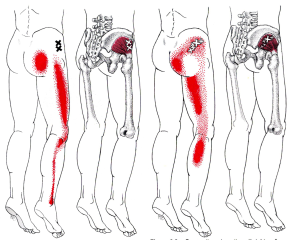This week’s Muscle Monday will profile and highlight the Piriformis muscle. I’ll highlight the actions, associated problems, self-care techniques and some trivia about Piriformis.

What is it and where is it?
- All muscle names have latin roots. In latin Piriformis means “pear shaped” and thus it forms that shape deep in the hip.
- The Piriformis muscle lies deep to the more superficial Gluteus Maximus and is a relatively small muscle.
- It originates on the underside of the sacrum and is widest as it then narrows to a small tendon that inserts into the greater trochanter or bony part of your hip.
What does it do?
- Along with other lesser known muscles that are deep in the Glutes it primarily rotates the hip laterally/externally. To better understand the function if you sit in a chair and squeeze your butt using only your hip to pull the knee away from the midline of the body you are contracting the Piriformis. It is important to note the angle of your hip when you perform this action; commonly when sitting, the hip is flexed at 90º.
- However, the Piriformis has a dual personality when it comes to muscle actions. If you flex the hip past 60º, i.e. lean forward while sitting, then the action changes to abduction and its function changes pulling the hip and thigh away from the center line of the body.
- This is why it can be tricky to stretch because its function can change depending on the angle of flexion in the hip.
Why it can literally be a pain in the ass!
- Quite often it gets a bum rap (pun intended!) Frequently people will think it is the culprit of sciatica. However, true sciatica is caused by compression on the nerve root that originates in the lumbar spine.
- But the Pirifomis can come into play with a nerve compression syndrome that is called Piriformis Syndrome or “Pseudo-Sciatica”. When this happens one of the causes can be the Piriformis because the sciatic nerve typically passes underneath the Piriformis muscle. When Piriformis becomes tight it can compress on the sciatic nerve and cause pain that refers down the back of the leg as far as the knee.
- However, while we’re quick to blame Piriformis for this problem and attack it like an annoying fly, other muscles can come into play for this referred pain down the leg, notably trigger point activity in Gluteus Minimus and Medius.

Referral patterns of Gluteus Minimus. A lot like sciatic pain! I’ve seen this quite often in my clinical experience. So it’s always important to think outside the box and along kinetic chains. Additionally trigger points in the low back muscle Quadratus Lumborum can refer pain to the sacrum, which can feel like more of a pain in the butt.
- A lesser seen anomaly of this muscle is one in which the sciatic nerve actually passes through the Piriformis, instead of underneath or deep to it. However, this is something they teach us in anatomy but very rarely happens.
- Sitting usually doesn’t make things better and can cause it to become tight and unhappy.
What helps it?
- I’m biased of course but massage is typically very helpful. But even more helpful than massage is a controlled stretch I use with my clients called an Isotonic Eccentric Contraction (IEC). The link describes it adequately but it is hard to describe in layman’s terms. I have found that if any muscle is either hypersensitive or hypertonic, then an IEC reduces both tenderness and tightness in the muscle. Below I’ve inserted an effective massage technique that is a little different, but it employs active movement by the client along with direct pressure on the Piriformis. This is another technique I use often and highly favor.
- One thing that can really help your Piriformis is making sure the other muscles in the hip are all working equally. Weakness in Gluteus Medius can create problems around the hip, especially with runners. This leads to a compromised gait, especially when combined with fatigue, so strengthening the Glute Medius will usually make life better.
- If it is aggravated while driving that might occur due to an overly soft seat or sitting unevenly. Try placing a rolled up hand towel under the affected side to add a little bolstering and see if that helps.
- Using a foam roller on the whole hip region can be a great self-care technique. Start by sitting on the foam roller and then rolling to the side to access the Piriformis and the other muscles in the hip as well.
- If it is being very stubborn you can lie on the floor and use a tennis ball under the hip to get a little more focused attention into the muscle. But this can be a little intense, so relax, breathe and allow the muscle to soften.
- From a sitting position you can cross the affected side/leg over your other leg. It’s the classic position men use when they cross their leg, like a figure four. Then lean front and play with the angle until you feel the stretch you’re looking for. Don’t overstretch and to avoid this contract your abdominal muscles as well as your adductors (groin muscles) to find a balance in the stretch/strengthen paradigm.
- A great yoga posture for the Piriformis is the Pigeon Pose if you have access to the floor.
Like every muscle in the body, the Piriformis works in combination with many other muscles. It rarely is the sole culprit for pain but can be a contributor. Understanding its function and purpose will help to increase your own awareness of how it can be a major player in your own body!

Super helpful. I think this is my prob. Started when trail running. Left side only. All those referred pain spots you show are identical to my pain. I have not run since. A couple of months. I’ll try the Yoga stretch. I don’t think many Drs or PT types are too good at diagnosing. They go right to SI joint and Siatica. Thank you, Matthew Buzzell
Matthew,
Glad to be of help. Keep me abreast of your progress.
In good health!
Matt Gibble